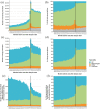The dynamics of the general practitioner-nephrologist collaboration for the management of patients with chronic kidney disease before and after dialysis initiation: a mixed-methods study
- PMID: 36199764
- PMCID: PMC9527990
- DOI: 10.1177/20406223221108397
The dynamics of the general practitioner-nephrologist collaboration for the management of patients with chronic kidney disease before and after dialysis initiation: a mixed-methods study
Abstract
Background: Effective collaboration between general practitioners (GP) and nephrologists is crucial in CKD care. We aimed to analyse GPs' and nephrologists' presence and involvement in CKD care and assess how they intertwine to shape patients' trajectories.
Methods: We conducted a mixed-methods study that included all patients with CKD who started dialysis in France in 2015 (the REIN registry) and a sample of nephrologists and GPs. We quantified professionals' presence through patients' reimbursed healthcare from the French National Health Data System, 2 years before and 1 year after dialysis start. Involvement in CKD care was derived from the nephrologists' and GPs' interviews.
Results: Among 8856 patients included, nephrologists' presence progressively increased from 29% to 67% of patients with a contact during the 2 years before dialysis start. However, this was partly dependent on the GPs' referral practices. Interviews revealed that GPs initially controlled the therapeutic strategy on their own. Although unease grew with CKD's management complexity, reducing their involvement in favour of nephrologists, GPs' presence remained frequent throughout the pre-dialysis period. Upon dialysis start, nephrologists' presence and involvement became total, while GPs' greatly decreased (48% of patients with a contact at month 12 after dialysis start). Collaboration was smooth when GPs maintained contact with patients and could contribute to their care through aspects of their specialty they valued.
Conclusions: This mixed-methods study shows presences and forms of involvement of GPs and nephrologists in CKD care adjusting along the course of CKD and unveils the mechanisms at play in their collaboration.
Keywords: care trajectories; chronic kidney disease; collaboration; general practitioner; healthcare data; mixed methods.
© The Author(s), 2022.
Conflict of interest statement
Competing interests: The authors declared the following potential conflicts of interest with respect to the research, authorship, and/or publication of this article: All authors have completed the ICMJE uniform disclosure form at www.icmje.org/coi_disclosure.pdf and declare: no support from any organisation for the submitted work; no financial relationships with any organisations that might have an interest in the submitted work in the previous three years; no other relationships or activities that could appear to have influenced the submitted work. In addition, the results presented in this paper have not been published previously in whole or part, except in abstract format.
Figures


Similar articles
-
Nephrologists' perspectives on ambulatory care of patients with non-dialysis chronic kidney disease - A qualitative study.Health Soc Care Community. 2019 Jul;27(4):e438-e448. doi: 10.1111/hsc.12744. Epub 2019 Apr 4. Health Soc Care Community. 2019. PMID: 30945392
-
Medicines optimization for patients with chronic kidney disease in the outpatient setting: the role of the clinical pharmacist.Int J Pharm Pract. 2021 Dec 4;29(6):587-597. doi: 10.1093/ijpp/riab033. Int J Pharm Pract. 2021. PMID: 34244750 Clinical Trial.
-
Experiences of US Nephrologists in the Delivery of Conservative Care to Patients With Advanced Kidney Disease: A National Qualitative Study.Am J Kidney Dis. 2020 Feb;75(2):167-176. doi: 10.1053/j.ajkd.2019.07.006. Epub 2019 Sep 27. Am J Kidney Dis. 2020. PMID: 31570175 Free PMC article.
-
Predialysis Care Trajectories of Patients With ESKD Starting Dialysis in Emergency in France.Kidney Int Rep. 2020 Oct 31;6(1):156-167. doi: 10.1016/j.ekir.2020.10.026. eCollection 2021 Jan. Kidney Int Rep. 2020. PMID: 33426395 Free PMC article.
-
What does the French REIN registry tell us about Stage 4-5 CKD care in older adults?Front Nephrol. 2023 Jan 17;2:1026874. doi: 10.3389/fneph.2022.1026874. eCollection 2022. Front Nephrol. 2023. PMID: 37675001 Free PMC article. Review.
Cited by
-
Sex disparities in the utilization of nurse-assisted peritoneal dialysis: a mediation analysis using data from the REIN registry.Clin Kidney J. 2024 Jan 3;17(1):sfad301. doi: 10.1093/ckj/sfad301. eCollection 2024 Jan. Clin Kidney J. 2024. PMID: 38213499 Free PMC article.
-
Experience of Chronic Kidney Disease and Perceptions of Transplantation by Sex.JAMA Netw Open. 2024 Jul 1;7(7):e2424993. doi: 10.1001/jamanetworkopen.2024.24993. JAMA Netw Open. 2024. PMID: 39083269 Free PMC article.
-
Patient Care Gaps Prior to Maintenance Dialysis Initiation: A Population-Based Retrospective Study.Can J Kidney Health Dis. 2023 Nov 17;10:20543581231212134. doi: 10.1177/20543581231212134. eCollection 2023. Can J Kidney Health Dis. 2023. PMID: 38020481 Free PMC article.
References
-
- Shahinian VB, Saran R. The role of primary care in the management of the chronic kidney disease population. Adv Chronic Kidney Dis 2010; 17: 246–253. - PubMed
LinkOut - more resources
Full Text Sources

